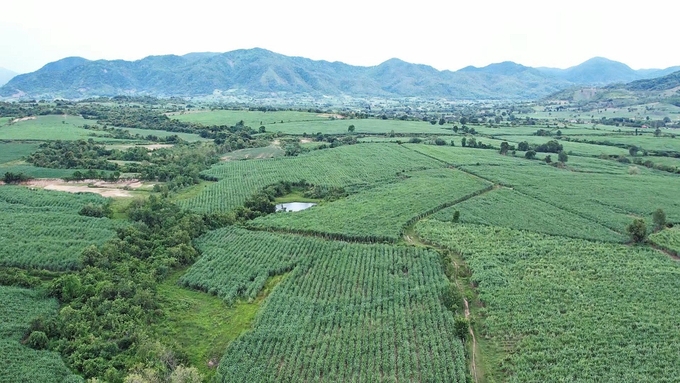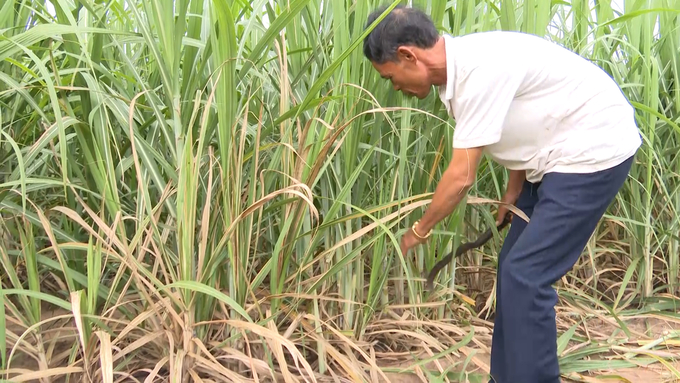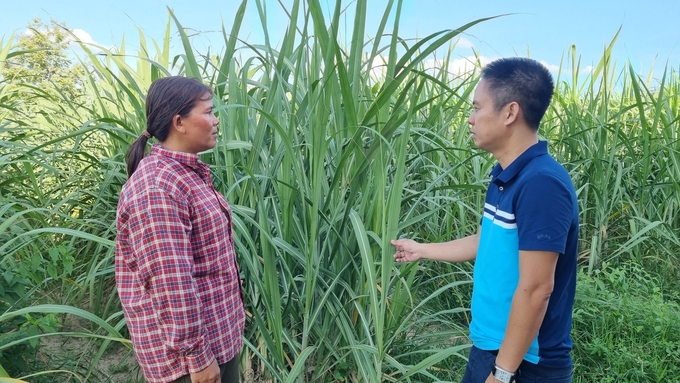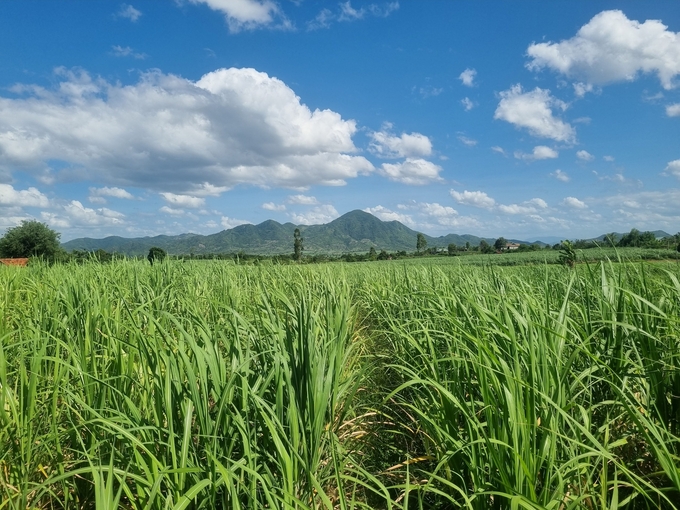June 21, 2025 | 02:40 GMT +7
June 21, 2025 | 02:40 GMT +7
Hotline: 0913.378.918
June 21, 2025 | 02:40 GMT +7
Hotline: 0913.378.918

The vast sugarcane field in Ia Mlah commune. Photo: Tuan Anh.
In Krong Pa district these days, one can easily come across vast sugarcane fields with a lush green color. In recent years, sugarcane has gradually become the main crop of the locality as the cultivation area continues to expand. People have high hopes that sugarcane will contribute to economic development and lead to prosperity.
Arriving in Ia Mlah commune (Krong Pa district), we were pleasantly surprised by the sugarcane cultivation movement among the local residents. Every family, whether planting a small or large area, has joined in growing sugarcane. The choice of sugarcane cultivation for economic development within families stems from the fact that many sugarcane enterprises have selected this area to develop their raw material sources. Accordingly, these enterprises provide support to residents by investing in seedlings, fertilizers, and also ensure product sales upon harvest.
Mr. Le Kim Anh’s family (Chinh Hoa, Ia Mlah commune) started their livelihood on this land in 1985 under the new economic policy. At that time, the family only knew how to grow cassava and rice, so life was quite challenging. About 10 years ago, the family decided to switch to sugarcane cultivation and gradually introduced mechanization into production, which led to an improvement in their economic conditions. Currently, Mr. Anh’s family has 9 hectares of sugarcane, generating an annual income of nearly 1 billion VND on average.

Thanks to intensive cultivation and active irrigation, the sugarcane yield in Krong Pa in many places reached 140 tons/ha, twice as high as in other localities. Photo: Tuan Anh.
“In the past, taking care of sugarcane required a lot of time, especially in terms of fertilizing and weed control. Since the adoption of mechanization, caring for sugarcane has become much easier and yields are significantly higher. While in previous years, the sugarcane yield was only around 50 - 60 tons/ha, currently, with the application of a drip irrigation system and synchronized machinery, the yield is much higher, reaching about 120 tons/ha. Along with the fact that enterprises purchase sugarcane from farmers at high prices, sugarcane cultivation has brought substantial success to the farmers”, Mr. Anh expressed enthusiastically.
Under the scorching sun of this region, the sugarcane fields of Mr. Phung Van Hoan’s family (Du, Ia Mlah commune) remain lush green, with straight and healthy plants. With a 2-hectare sugarcane plantation, Mr. Hoan is confident that the upcoming harvest will yield around 140 tons/ha. This confidence is grounded in the fact that in the previous season, despite planting only 5 rows of sugarcane, his family achieved a yield of 70 tons.
"This year, my family has boldly invested in an efficient irrigation system and implemented a systematic care process, so the yield is undoubtedly going to be even higher. Currently, the purchasing price from the factory is around 1,300 VND/kg. If this price remains stable until the harvest season, farmers will enjoy significant profits, with returns of hundreds of millions of VND per hectare," Mr. Hoan stated. He also added that compared to cultivating cassava, sugarcane is easier to manage and brings in much higher profits.
In Dat Bang commune (Krong Pa district), the internal roads leading to production sites, along with abundant irrigation sources, have contributed to the increasing prosperity of sugarcane fields in this area.

People in Dat Bang commune are strongly converting from planting cassava to sugarcane. Photo: Tuan Anh.
Mr. Ha Van Phuoc’s family (Ia Rnho, Dat Bang commune) cultivates over 5 hectares of sugarcane through a partnership with enterprises. In the previous crop season, on average, Mr. Phuoc’s family harvested nearly 100 tons of raw sugarcane per hectare, resulting in a profit of over 60 million VND. Recognizing the high profitability of sugarcane, this year, his family decided to rent additional land to cultivate an additional 2.8 hectares.
"For the new cultivation areas, enterprises come to survey and assess for investment. On average, for 1 hectare, the enterprise invests in seedlings, fertilizers... which translates to about 30 million VND. Along with that, since the enterprise also purchases the products, farmers find it very advantageous to invest in sugarcane cultivation", Mr. Ha Van Phuoc stated.
In recent years, aiming to achieve the goal of building new rural areas and enhancing production efficiency, Krong Pa district has focused on developing large fields for certain crops, including sugarcane.
In 2017, Ia Mlah commune pioneered the implementation of a large sugarcane field model. The locality's strength lies in its extensive agricultural land and the benefits derived from the Ia Mlah irrigation system, ensuring a consistent water supply. As a result, the mechanization process from land preparation, planting, nurturing, to harvesting is highly convenient, and the yield surpasses the previous production methods.
Mr. Kso Luan, Chairman of Ia Mlah commune's People's Committee, shared that the locality has favorable conditions for sugarcane cultivation. The Ia Mlah irrigation system eliminates concerns about water supply. Moreover, there are two sugarcane factories in the area that invest in partnerships with local residents to develop the raw material zone.
"Since the economic development from sugarcane cultivation, the lives of the people here have changed significantly. Sugarcane provides a much higher yield and income compared to cassava cultivation, thereby improving the lives of the local population," Mr. Luan said.

Krong Pa holds a favorable position in growing sugarcane. Photo: Tuan Anh.
Mr. Ho Van Thao, Chairman of the People's Committee of Krong Pa district, stated that there are over 2,000 hectares of sugarcane in the district. It is expected that the cultivated area of sugarcane will continue to increase by 500 to 1,000 hectares annually.
According to Mr. Thao, Krong Pa district has a climate and soil conditions that are very suitable for sugarcane growth. Especially in recent times, sugarcane has been supported by businesses to be cultivated using scientific methods and advanced irrigation technologies, resulting in outstanding yields and quality. Compared to other regions, sugarcane in Krong Pa district has nearly doubled the yield, ranging from 100 to 140 tons per hectare.
Mr. Ho Van Thao, Chairman of the People's Committee of Krong Pa district, stated, "To develop sustainable sugarcane cultivation, the collaboration of businesses is crucial in terms of investment support, market orientation, and the development of raw material zones along the value chain. From the government side, we will support water supply for irrigation and infrastructure development to facilitate harvesting and transportation for the local residents".
Translated by Nguyen Hai Long
![Turning wind and rain into action: [9] Digitizing hydrometeorological data in response to climate change](https://t.ex-cdn.com/nongnghiepmoitruong.vn/608w/files/news/2025/06/17/z6704423696987_15fd32ffc26d590d204d520c9dac6786-nongnghiep-165943.jpg)
(VAN) Farmers have begun accessing hydrometeorological applications to adjust their cropping schedules, aiming to ensure productivity and adapt to climate change.
![Turning wind and rain into action: [8] Real-time salinity detection and early warning technology](https://t.ex-cdn.com/nongnghiepmoitruong.vn/608w/files/news/2025/06/17/z6704423696987_15fd32ffc26d590d204d520c9dac6786-nongnghiep-151127.jpg)
(VAN) Thanks to the integration of modern hydrological-hydraulic models, remote sensing technologies, and artificial intelligence, the accuracy of hydrological forecasting has significantly improved.
![Turning wind and rain into action: [7] Early disaster warnings help marine farmers minimize losses](https://t.ex-cdn.com/nongnghiepmoitruong.vn/608w/files/news/2025/06/17/z6704423696987_15fd32ffc26d590d204d520c9dac6786-nongnghiep-142942.jpg)
(VAN) In recent years, thanks to early disaster warnings and forecasting, marine farmers in Khanh Hoa province have been able to reduce risks and losses, thereby improving production efficiency.
![Turning wind and rain into action: [6] ‘Four on-the-spot’ disaster management software](https://t.ex-cdn.com/nongnghiepmoitruong.vn/608w/files/news/2025/06/17/e5a48259d6a262fc3bb3-nongnghiep-183800.jpg)
(VAN) By simply activating the scenario on the disaster management software, the relevant authorities immediately know how many households need to be evacuated, where to evacuate them to, and by what means of transportation…
![Turning wind and rain into action: [5] Hue applies modern technology in disaster forecasting](https://t.ex-cdn.com/nongnghiepmoitruong.vn/608w/files/news/2025/06/17/z6704423696987_15fd32ffc26d590d204d520c9dac6786-nongnghiep-093938.jpg)
(VAN) In Hue city, modern technology has recently been applied in meteorological and hydrological forecasting and warning, helping to reduce the damage caused by natural disasters.

(VAN) A cutting-edge farming technique being implemented on an experimental ranch in Arizona's Sonoran Desert has already saved a billion gallons of water over five years, according to Civil Eats.

(VAN) Poultry and pig production and the environment can be boosted through enhanced water technology, according to new research.